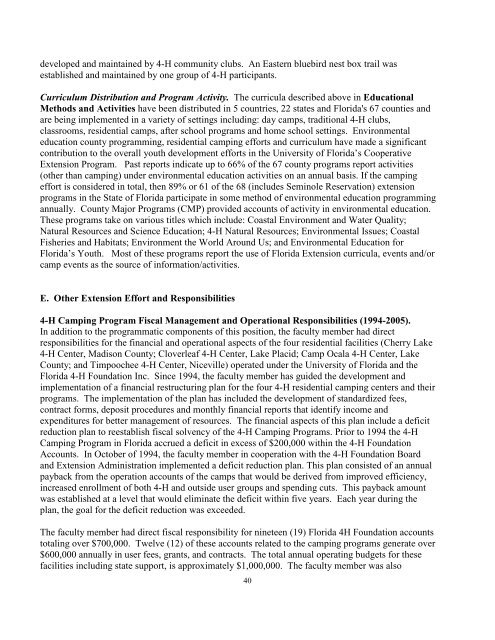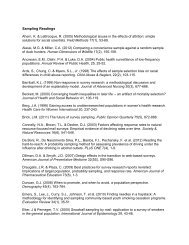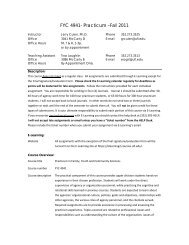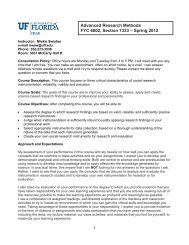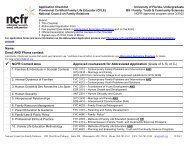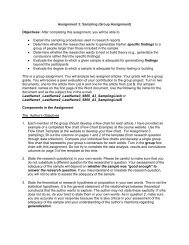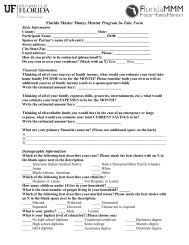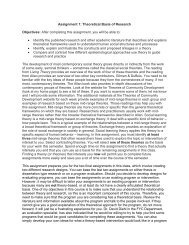Curriculum Vitae - University of Florida Family Youth and ...
Curriculum Vitae - University of Florida Family Youth and ...
Curriculum Vitae - University of Florida Family Youth and ...
You also want an ePaper? Increase the reach of your titles
YUMPU automatically turns print PDFs into web optimized ePapers that Google loves.
developed <strong>and</strong> maintained by 4-H community clubs. An Eastern bluebird nest box trail wasestablished <strong>and</strong> maintained by one group <strong>of</strong> 4-H participants.<strong>Curriculum</strong> Distribution <strong>and</strong> Program Activity. The curricula described above in EducationalMethods <strong>and</strong> Activities have been distributed in 5 countries, 22 states <strong>and</strong> <strong>Florida</strong>'s 67 counties <strong>and</strong>are being implemented in a variety <strong>of</strong> settings including: day camps, traditional 4-H clubs,classrooms, residential camps, after school programs <strong>and</strong> home school settings. Environmentaleducation county programming, residential camping efforts <strong>and</strong> curriculum have made a significantcontribution to the overall youth development efforts in the <strong>University</strong> <strong>of</strong> <strong>Florida</strong>’s CooperativeExtension Program. Past reports indicate up to 66% <strong>of</strong> the 67 county programs report activities(other than camping) under environmental education activities on an annual basis. If the campingeffort is considered in total, then 89% or 61 <strong>of</strong> the 68 (includes Seminole Reservation) extensionprograms in the State <strong>of</strong> <strong>Florida</strong> participate in some method <strong>of</strong> environmental education programmingannually. County Major Programs (CMP) provided accounts <strong>of</strong> activity in environmental education.These programs take on various titles which include: Coastal Environment <strong>and</strong> Water Quality;Natural Resources <strong>and</strong> Science Education; 4-H Natural Resources; Environmental Issues; CoastalFisheries <strong>and</strong> Habitats; Environment the World Around Us; <strong>and</strong> Environmental Education for<strong>Florida</strong>’s <strong>Youth</strong>. Most <strong>of</strong> these programs report the use <strong>of</strong> <strong>Florida</strong> Extension curricula, events <strong>and</strong>/orcamp events as the source <strong>of</strong> information/activities.E. Other Extension Effort <strong>and</strong> Responsibilities4-H Camping Program Fiscal Management <strong>and</strong> Operational Responsibilities (1994-2005).In addition to the programmatic components <strong>of</strong> this position, the faculty member had directresponsibilities for the financial <strong>and</strong> operational aspects <strong>of</strong> the four residential facilities (Cherry Lake4-H Center, Madison County; Cloverleaf 4-H Center, Lake Placid; Camp Ocala 4-H Center, LakeCounty; <strong>and</strong> Timpoochee 4-H Center, Niceville) operated under the <strong>University</strong> <strong>of</strong> <strong>Florida</strong> <strong>and</strong> the<strong>Florida</strong> 4-H Foundation Inc. Since 1994, the faculty member has guided the development <strong>and</strong>implementation <strong>of</strong> a financial restructuring plan for the four 4-H residential camping centers <strong>and</strong> theirprograms. The implementation <strong>of</strong> the plan has included the development <strong>of</strong> st<strong>and</strong>ardized fees,contract forms, deposit procedures <strong>and</strong> monthly financial reports that identify income <strong>and</strong>expenditures for better management <strong>of</strong> resources. The financial aspects <strong>of</strong> this plan include a deficitreduction plan to reestablish fiscal solvency <strong>of</strong> the 4-H Camping Programs. Prior to 1994 the 4-HCamping Program in <strong>Florida</strong> accrued a deficit in excess <strong>of</strong> $200,000 within the 4-H FoundationAccounts. In October <strong>of</strong> 1994, the faculty member in cooperation with the 4-H Foundation Board<strong>and</strong> Extension Administration implemented a deficit reduction plan. This plan consisted <strong>of</strong> an annualpayback from the operation accounts <strong>of</strong> the camps that would be derived from improved efficiency,increased enrollment <strong>of</strong> both 4-H <strong>and</strong> outside user groups <strong>and</strong> spending cuts. This payback amountwas established at a level that would eliminate the deficit within five years. Each year during theplan, the goal for the deficit reduction was exceeded.The faculty member had direct fiscal responsibility for nineteen (19) <strong>Florida</strong> 4H Foundation accountstotaling over $700,000. Twelve (12) <strong>of</strong> these accounts related to the camping programs generate over$600,000 annually in user fees, grants, <strong>and</strong> contracts. The total annual operating budgets for thesefacilities including state support, is approximately $1,000,000. The faculty member was also40


